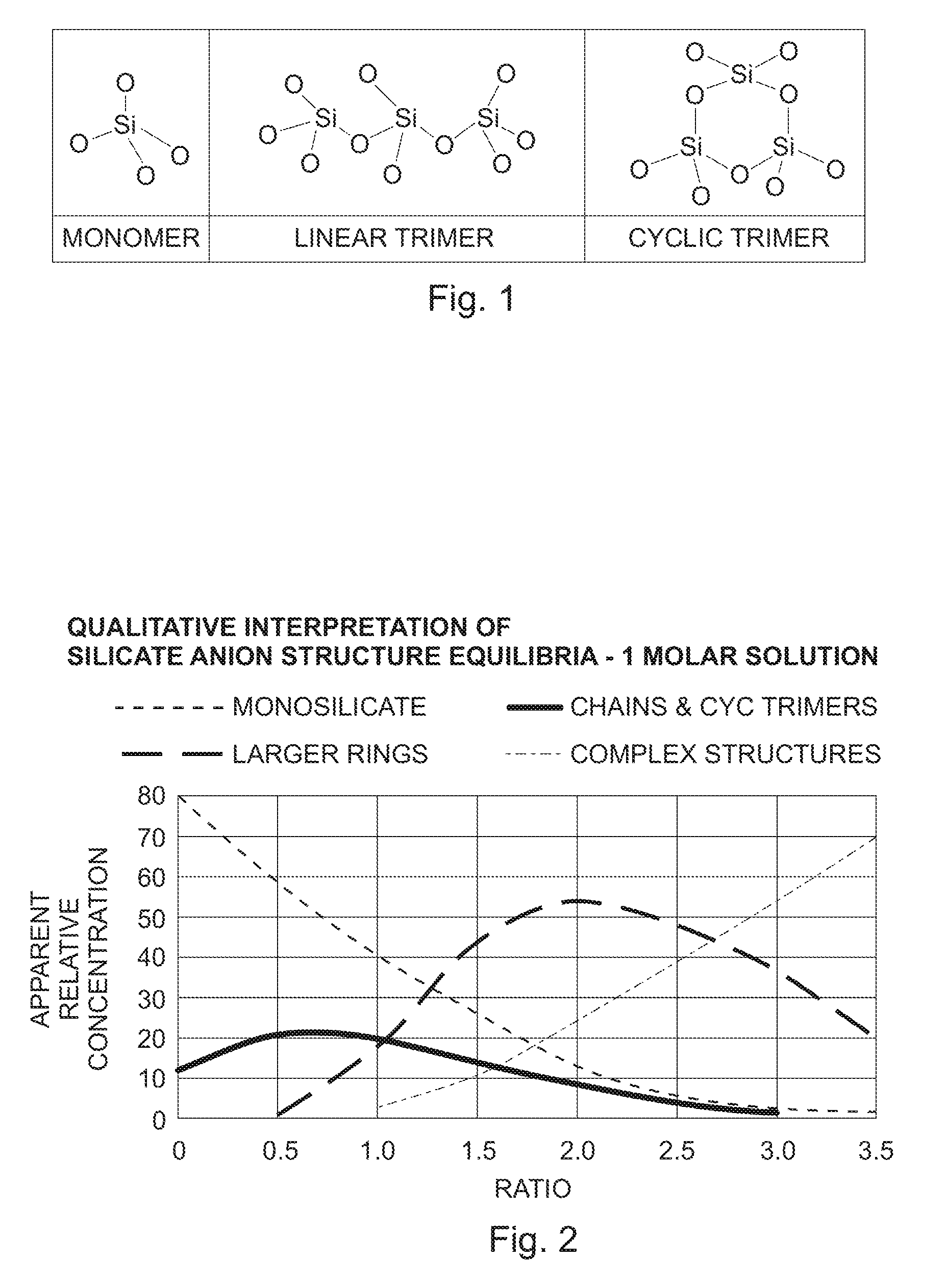Use of high ratio aqueous alkali silicates in drilling fluids
a technology of drilling fluid, which is applied in the direction of drilling composition, chemistry apparatus and processes, etc., can solve the problems of minor skin and eye irritation, alkalinity affecting the disposal of silicate-based drilling waste, and inability to use high ratio aqueous alkali silicate in drilling fluid, so as to prevent shale delamination and prevent accretion of bitumen, prevent hydration and disper
- Summary
- Abstract
- Description
- Claims
- Application Information
AI Technical Summary
Benefits of technology
Problems solved by technology
Method used
Image
Examples
example 1
[0050]Example 1 demonstrates the effectiveness of high ratio sodium silicate at sealing microfractures and the prevention of shale delamination. Core samples of Shaftsbury shale were selected of similar size, shape, fracture level and lamination. Drilling fluids were formulated to an equivalent SiO2 level of 2.5% by weight using the drilling fluid in Table 3. The selected shale was placed in 350 grams of the indicated drilling fluid and hot rolled for 16 hours at 120° F. Visible observations on shale delamination are noted in Table IV.
[0051]
TABLE IVFractured, laminated shale after hot rolling2.53.04.03.0 groundControlAqueousAqueousAqueousK SilicateColloidalNo SiO2K SilicateK SilicateK SilicatesilicatesilicaBase fluid350 g307.9 g301.1 g300.8 g338.3 g328.1 gShale inhibitor— 42.1 g 48.9 g 49.2 g 11.6 g 21.9 gWeight before30.59 g 40.94 g38.09 g41.33 g33.74 g41.67 ghot rollingAfter hotMultipleSingleIntactIntactMultipleMultiplerollingdelaminationdelam.delam.delam.
example 2
[0052]Example 2 compares the shale dispersion of simulated Arne cuttings (mesh size 5-8 inch) by hot rolling 20 gram cuttings for ˜16 hours at 150° F. in a high ratio potassium silicate. Drilling fluids were formulated to have 2% SiO2 by weight in the drilling fluid. After hot rolling the cuttings were screened on 20 mesh screen and rinsed with deionized water and dried. Table V indicates the weight of recovered shale.
[0053]
TABLE VArne shale cuttings recovered after hot rolling2.53.04.0ControlAqueousAqueousAqueousColloidalNo SiO2K SilicateK SilicateK SilicatesilicaBase fluid350 g 316.3 g 310.9 g 310.7 g 332.5 ginhibitor—33.7 g39.1 g39.3 g 17.5 gWeight of20 g 20 g 20 g 20 g 20 gshaleAfter hot9.7 g 19.5 g17.9 g17.8 g 1.4 grolling% Shale48.5%97.5%89.5%89%7%Recovery
example 3
[0054]Example 3 compares the shale dispersion of simulated Joli Fou shale cuttings at different concentrations of high ratio aqueous sodium silicate. Shale recovery is also compared against standard ratio sodium silicate and colloidal silica at 2% SiO2 by weight in the drilling fluid. Cuttings were subject to the same testing procedure described in Example 2. Table VI presents the results of this experiment.
[0055]
TABLE VIShale recovery vs. concentration of high ratio aqueous sodium silicate0.5% SiO21% SiO22% SiO22% SiO24.5 ratio4.5 ratio4.5 ratio3.2 ratio2%ControlNaNaNaNaColloidalNo SiO2SilicateSilicateSilicateSilicateSilicaBase fluid350 g340.9 g 331.8 g 313.5 g 325.6 g 332.5 g inhibitor— 9.1 g18.2 g36.5 g24.4 g17.5 gWeight of shale 20 g 20 g 20 g 20 g 20 g 20 gAfter hot rolling 8.0 g11.6 g13.4 g17.0 g16.4 g 9.1 g% Shale40%58%67%85%82%45.5%Recovery
PUM
| Property | Measurement | Unit |
|---|---|---|
| molar ratio | aaaaa | aaaaa |
| molar ratio | aaaaa | aaaaa |
| molar ratio | aaaaa | aaaaa |
Abstract
Description
Claims
Application Information
 Login to View More
Login to View More - R&D
- Intellectual Property
- Life Sciences
- Materials
- Tech Scout
- Unparalleled Data Quality
- Higher Quality Content
- 60% Fewer Hallucinations
Browse by: Latest US Patents, China's latest patents, Technical Efficacy Thesaurus, Application Domain, Technology Topic, Popular Technical Reports.
© 2025 PatSnap. All rights reserved.Legal|Privacy policy|Modern Slavery Act Transparency Statement|Sitemap|About US| Contact US: help@patsnap.com


